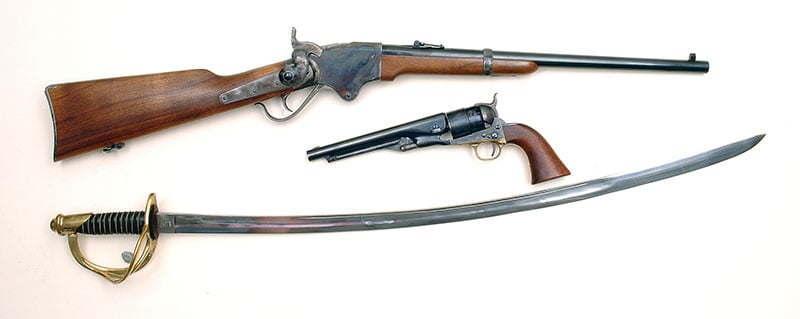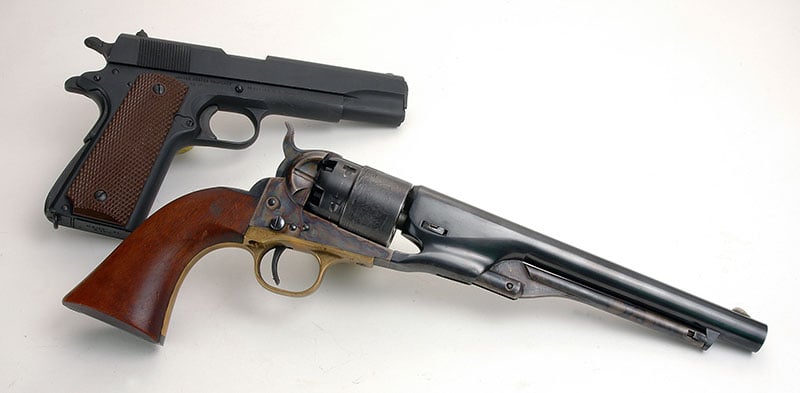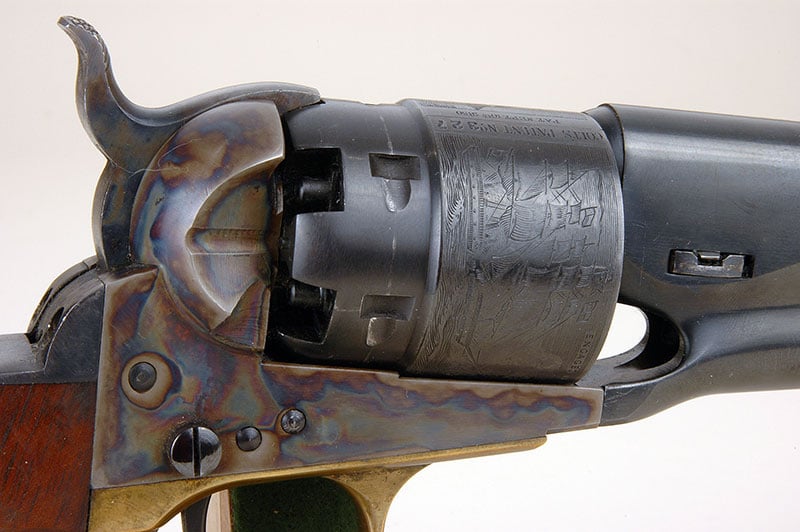THE 1860 ARMY .44
Part 5 of 12 Part Genesis of the Colt Single Action
For about a decade Samuel Colt was quiet as far as introducing new revolver models. Obviously they were using all their factory’s production capacity just keeping up with orders for the hugely successful .31 caliber Model 1849 and .36 caliber Model 1851 Navy. When they finally did introduce a new handgun it was one that many consider their pinnacle of cap and ball revolver development. Collectors have named it the Model 1860 Army and indeed it appeared at a very fortuitous time, in regards both to sales and the Federal Government’s needs.
The first battles of the American Civil War (1861-1865) basically coincided with the new revolver’s debut and the U.S. Army quickly adopted it for issue to cavalry troops, hence the name bestowed by collectors if not by Samuel Colt himself. There were not enough Model 1860s produced during the Civil War to equip all Federal cavalrymen, so just about every sort of functional revolver was pressed into service. Still if any one handgun could be labeled as “standard issue” it would be Colt’s newest. In fact if someone wanted to estimate what a typical U.S. Army cavalryman of the Civil War carried for weapons they couldn’t be too wrong to say a Spencer carbine, a Colt Model 1860 revolver and a Model 1860 saber.
First .44
Worthy of note is the Model 1860 Army was Colt’s first .44 caliber revolver since the 3rd Model Dragoon. All previous .44 caliber Colt revolvers had been huge handguns weighing over four pounds and hence far too large for comfortable carry in a holster on one’s person. Therefore, through the decade of the 1850s, Colt’s “belt” revolver had been the .36 caliber Model 1851 Navy. It weighed 42 ounces with 7½” barrel. Some thoughtful designer at the Colt factory determined a way to combine .44 caliber punch with the .36 Navy’s moderate size. This likely wasn’t Samuel Colt himself because by this time his health was failing. He died in 1862.
The method by which this was accomplished was with a rebated cylinder. Its rearmost three quarters of an inch is the same size as a Model 1851’s cylinder but its foremost 1 1/8″ is wider so as to accept the larger .44 caliber balls. The basic frame is the same size as a Model 1851’s but where the cylinder becomes larger the frame is recessed deeper. It was an ingenuous method of making a revolver of large caliber but keeping it within acceptable limits for comfortable carry.
Another thing for which the Model 1860 Army gained recognition is its gracefulness. Gone was the octagon barrel of the ’51 Navy including its large rear block through which the loading rammer pivoted. The entire barrel of the ’60 Army is smoothly curved. Another new thing tried only once with Colt cap and ball revolvers was the longer grip frame of the Model 1860. It is one-quarter inch longer than that of the Model 1851 “Navy.” Combined, the smoothly curved 8″ barrel and extra long grip frame made Colt’s last .44 caliber revolver both distinctive and attractive in appearance. Some early ones were given 7 ½” inch barrels but the vast majority had the 8″ length.
Another idea tried with the Model 1860 was flutes on the cylinder between the chambers. This development did not catch on and was quickly discontinued. One has to question why flutes were introduced in the first place. One theory is weight savings, but the amount shaved from an unfluted Model 1860’s 42 ounces was minimal. A more logical explanation is the flutes were put there to give a place for grasping the cylinder to help it rotate when badly fouled. Black powder fouling will quickly cause a revolver’s cylinder to bind if not properly lubricated. Regardless, it’s interesting to note cylinder flutes did not catch on much with cap and ball revolvers, but became standard for metallic cartridge revolvers only a few years later.
Loads
In previous segments it has been shown the Colt/Walker and Colt Dragoon .44 caliber cap and ball revolver cylinders held 60 and 50 grains of black powder respectively with 148-grain pure lead round balls. Those charges chronographed at about 1,170 and 1,010 fps from the 9″ and 7 ½” barrels of those two early Colt .44 caliber revolver types. By the advent of the Model 1860 Army, evidently it had been determined that man against man combat did not require such heavy powder charges. Loaded in the same manner as with the Colt Walker and Colt Dragoon, the 2nd Generation Colt Model 1860 Army cylinder will hold only 30 grains of Goex FFFg black powder. That is with an Ox-Yoke Wonder Wad under the 148-grain round ball for lubrication. Velocity given by that charge is approximately 820 fps.
As will be seen in following installment, Colt did produce other cap and ball revolvers after the Model 1860 Army, but this one was the apex of the genre. Everything that followed simply consisted of minor changes and alterations of already existing designs. Nothing earthshakingly new came about until metallic handgun cartridges became the norm.
Click Here To View List And Links To All Colt Series Articles










